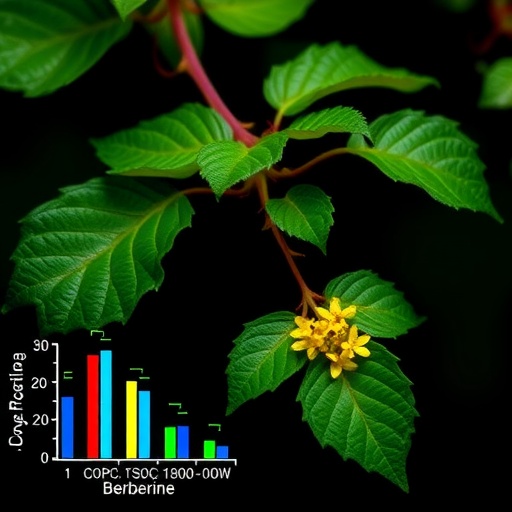Recent research has shed new light on the pharmacological properties of naturally occurring compounds such as berberine and berberrubine. These compounds, which are derived from various plants including Goldenseal and Barberry, have long been recognized for their medicinal benefits. However, a novel study conducted by Xiao et al. has revealed their intriguing role in enhancing the expression of CYP3A4, a pivotal enzyme involved in drug metabolism. This enzyme is essential for the biotransformation of a wide array of pharmaceuticals, thus influencing their effectiveness and toxicity. The newfound ability of berberine and berberrubine to promote CYP3A4 expression through the modulation of the nuclear receptor PXR could have significant implications for the field of pharmacology.
CYP3A4, a member of the cytochrome P450 family, plays a critical role in the oxidative metabolism of numerous drugs, including statins, antidepressants, and antiepileptics. Its activity can vary widely among individuals, influenced by factors such as genetics, environment, and concurrent medication use. The study by Xiao et al. highlights a previously underappreciated area of research: the impact of herbal compounds on CYP3A4 expression. The ability of berberine and berberrubine to enhance CYP3A4 expression presents opportunities for drug interactions that could either increase therapeutic efficacy or precipitate adverse effects.
Central to the study’s findings is the nuclear receptor PXR (pregnane X receptor), which serves as a master regulator of CYP3A4 transcription. PXR activation leads to the transcriptional upregulation of CYP3A4 and other drug-metabolizing enzymes. Xiao and colleagues examined the effects of berberine and berberrubine on PXR binding and subsequent activation. Utilizing both in vitro and in vivo models, they documented that these compounds facilitate PXR’s binding to its DNA response elements, thereby enhancing the transcriptional activation of CYP3A4. This mechanism underscores the potential of certain herbal compounds not only as therapeutic agents but also as modifiers of drug metabolism.
The therapeutic implications of this research are manifold. On one hand, the enhanced expression of CYP3A4 could lead to increased metabolism of co-administered drugs, a desirable effect in specific contexts but potentially risky in others. For instance, patients taking medications that rely on CYP3A4 for clearance must be cautious if they also consume berberine or berberrubine, as this could lead to sub-therapeutic levels and compromised treatment outcomes. Conversely, in conditions where drug metabolism is substantially diminished, the introduction of these compounds might help sustain effective drug concentrations in the system.
Additionally, the specificity of PXR as a target for these compounds opens the door for tailored treatment strategies. By understanding how berberine and berberrubine interact with PXR and subsequently regulate CYP3A4, clinicians may harness this knowledge to enhance drug regimens for patients, particularly those with chronic conditions requiring polypharmacy. It invites further investigation into the broader implications of herbal medicine on pharmacokinetics and pharmacodynamics.
The study’s methodology employed advanced techniques to validate its findings. Researchers utilized luciferase reporter assays to evaluate the transcriptional activity of CYP3A4 in the presence of berberine and berberrubine. These assays allowed for quantifiable measurement of CYP3A4 expression levels, providing a solid foundation for the conclusions drawn. Furthermore, the in vivo experiments demonstrated increased CYP3A4 levels in animal models following treatment with these compounds, supporting the initial in vitro observations and reinforcing the relevance of this research to potential clinical applications.
Moreover, the implications of these findings extend beyond simple pharmacokinetics; they intersect with the public health domain. The increased use of herbal supplements in recent years necessitates rigorous examination of their interactions with conventional medicines, emphasizing the importance of understanding how natural compounds influence drug metabolism. Health professionals must remain vigilant in educating patients about the possible interactions between prescription medications and herbal supplements, with findings from studies like this serving as a crucial resource.
This research also poses broader philosophical questions regarding the role of traditional medicine in modern healthcare. As we navigate an era where evidence-based medicine is paramount, integrating ancient herbal wisdom with contemporary pharmacological practices could revolutionize therapeutic strategies. The inclination toward plant-based compounds for treating ailments may offer safer, more holistic options, particularly as adverse drug reactions and drug-drug interactions remain prevalent concerns in medical practice.
As the scientific community continues to explore the intersection of herbal medicine and pharmacology, the findings regarding berberine, berberrubine, and CYP3A4 expression highlight an essential area of inquiry that deserves further attention. Future studies could investigate the long-term effects of these compounds on drug metabolism across diverse populations, potentially revealing variations in efficacy and safety profiles. In addition, unraveling the molecular mechanisms underlying PXR activation could pave the way for novel therapeutic agents designed to optimize drug metabolism.
In conclusion, the work conducted by Xiao et al. presents a significant advancement in our understanding of how herbal compounds can modulate critical pharmacokinetic parameters. The role of berberine and berberrubine in promoting CYP3A4 expression underscores the necessity for continued research into the therapeutic potential of natural products and their implications for drug metabolism. As more individuals turn to herbal remedies for health benefits, the findings of this study will serve as a stepping stone toward ensuring their safe integration into contemporary healthcare practices.
Ultimately, the potential for berberine and berberrubine to act as potent enhancers of drug metabolism reflects a growing acknowledgement of the complexities of pharmacogenomics and the necessity for individualized patient care strategies. This research not only opens exciting avenues for future exploration but reinforces the significance of blending traditional wisdom with cutting-edge science in the quest for effective and safe therapeutic interventions.
Subject of Research: The effects of berberine and berberrubine on CYP3A4 expression via PXR binding.
Article Title: Berberine and berberrubine promote the expression of CYP3A4 via enhancing the binding of nuclear receptor PXR.
Article References:
Xiao, Gm., Lu, T., Zhu, D. et al. Berberine and berberrubine promote the expression of CYP3A4 via enhancing the binding of nuclear receptor PXR. BMC Pharmacol Toxicol 26, 187 (2025). https://doi.org/10.1186/s40360-025-01026-7
Image Credits: AI Generated
DOI: https://doi.org/10.1186/s40360-025-01026-7
Keywords: berberine, berberrubine, CYP3A4, PXR, drug metabolism, herbal medicine, pharmacology, pharmacogenomics.




